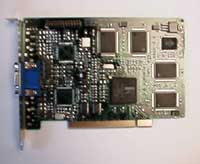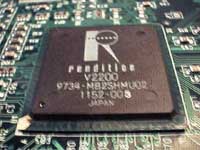Hercules Thriller 3D Rendition V2x00 Accelerator
by Anand Lal Shimpi on August 5, 1997 2:56 PM EST- Posted in
- GPUs
Rendition Verite 2100 - A chipset, the heart of Diamond's new low cost alternative to the 2D/3D Combo Card market, the Stealth II 3D.
Rendition Verite 2200 - Like the Verite 2100, runs at a higher clock speed, and the heart of Hercules' new alternative to the 2D/3D Combo Card market, the Thriller 3D.
The Thriller 3D was one of the most highly anticipated cards out of all of those announced that were based on the V2x00 chipset. What made the Thriller 3D so special was that it was available in 4 different versions, a 4MB PCI, 8MB PCI w/ TV-In/Out, 4MB AGP, and an 8MB AGP w/ TV-In/Out. With options like that how could you possible go wrong with the Thriller 3D? Chances are...you can't
| Interface: | AGP 1x / PCI 2.1 |
| Chipset: | Rendition Verite V2200 |
| RAM: | 4MB/8MB 100MHz SGRAM |
| Data Path: | 128-bit |
| Horizontal Sync Signals: | 31.5KHz - 110KHz |
| Vertical Refresh: | 56Hz - 160Hz |
| RAMDAC: | 230MHz |
| TV Output: | Optional TV-In/TV-Out |
| Video Playback: | MPEG-1, Indeo, & Cinepak Supported |
| Supported Resolutions: | 640 x 480 - 1600 x 1200 |
| Supported Refresh Rates: | 56Hz - 160Hz |
The flashy box the Thriller 3D is packed in looks like something out of a comic book, but the contents of the box are far from a comical. Inside is the Thriller 3D itself, the drivers CD (and a few game CD's if you purchase the 8MB version), and a handy user's manual. The best comparison the Thriller 3D would make would be against the Diamond Stealth II, so the Hercules card was tested in the exact same environment as the Diamond. The difference in the ease of installation was astounding.
| The main test system the Thriller 3D was used in was an AOpen AX6L Pentium II - 300, after physically removing the previously installed Matrox Millennium II (PCI) without uninstalling the drivers (a scenario most users are put in whenever the upgrade their video card) the system loaded Windows 95 perfectly fine, Windows' Add New Hardware Wizard detected a newly installed Standard VGA Graphics Accelerator, at which point I stuck in the driver CD that installed the proper drivers for the Thriller 3D. A quick restart of Windows left the test system in a beautiful 1024 x 768 x 16-bit color video mode with no problems at all, for ease of installation the Thriller 3D definitely gets a 5 out of 5. |  |
Hercules, like most video card manufacturers provides drivers with their card that allow the current Color Depth and Resolution to be modified on the fly which is always a plus. The Thriller 3D, unlike the Stealth II, uses a 230MHz RAMDAC, and when using large monitors (17"+) at higher resolutions the Thriller 3D doesn't seem to lose any visual quality at all. The 2D visual quality is almost on par with the Matrox Millennium at higher resolutions.
| The Rendition Verite V2200 chipset does have support for OpenGL both under Windows 95 (Beta GL drivers) and under Windows NT (MCD). Under Quake 2 the Thriller 3D produced frame rates indistinguishable from a Diamond Monster 3D, while noticeably faster than the Diamond Stealth II. The Thriller 3D does support Direct X 5.0 like all good video cards should, fortunately the Thriller 3D's performance lead over the Stealth II does translate over to the Direct3D arena. The Direct3D test for the Thriller 3D, like the Stealth II, was JediKnight which ran quite smooth on all of the Socket-7 test systems used. |  |
The Hercules Manual was very disappointing, the manual itself did document the installation process decently, however it was apparent that the Thriller 3D manual was no different than the old Stingray 128 manual, in fact the Thriller 3D user's manual just contained some generic information about virtually all Hercules video cards. A bit of a disappointment...but the Thriller 3D is still a great card...
It is quite obvious that the Thriller 3D was targeted at the low end market, since the Pentium II test system was much more at home with the Riva 128 cards such as the Diamond Viper V330 and the STB Velocity 128. With the 4MB PCI version priced at $129, it is definitely worth the extra $30 to pick up one of these puppies instead of a Diamond Stealth II, however with the 8MB PCI version selling for about $240 buying a Canopus Total3D 128V (which also happens to feature TV-In/Out) for under $240 would probably be your best bet. For those Pentium II owners out there, the Thriller 3D may not be right for you as well, it would seem that for Pentium II owners a Riva 128 based card is probably your best bet for a combo card, and with the release of the first Voodoo2 cards upon us you may want to save your $240 for a Creative Labs, Diamond, or California Graphics Voodoo2 board and just hang on to your current 2D Card.










3 Comments
View All Comments
pavag - Sunday, July 3, 2016 - link
First comment!johnnycanadian - Monday, July 4, 2016 - link
First comment! ... dammit, I was just beat. I'll be quicker on the draw when the Monster3D is reviewed. :-)pavag - Sunday, July 3, 2016 - link
Couldn't resist to make first comment 19 years after the article was published :DJust reached this page by chance. I didn't even knew Anandtech was this old!